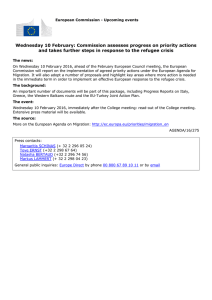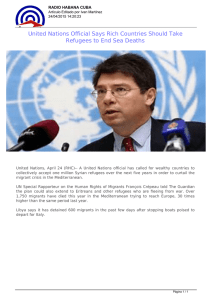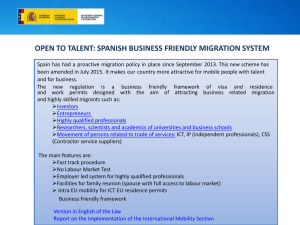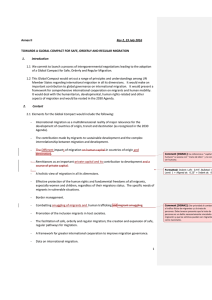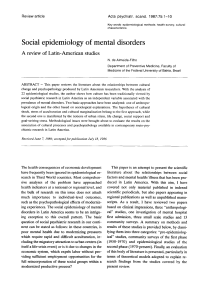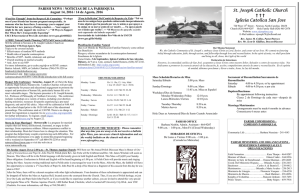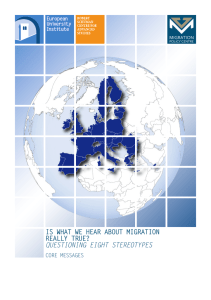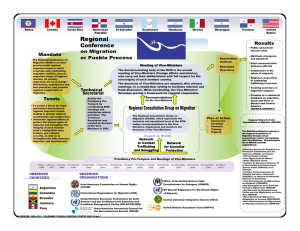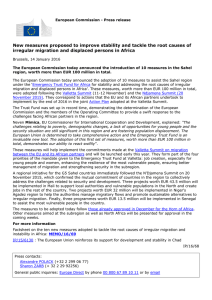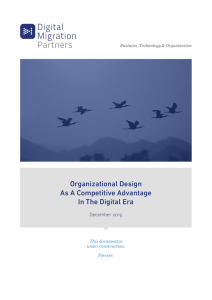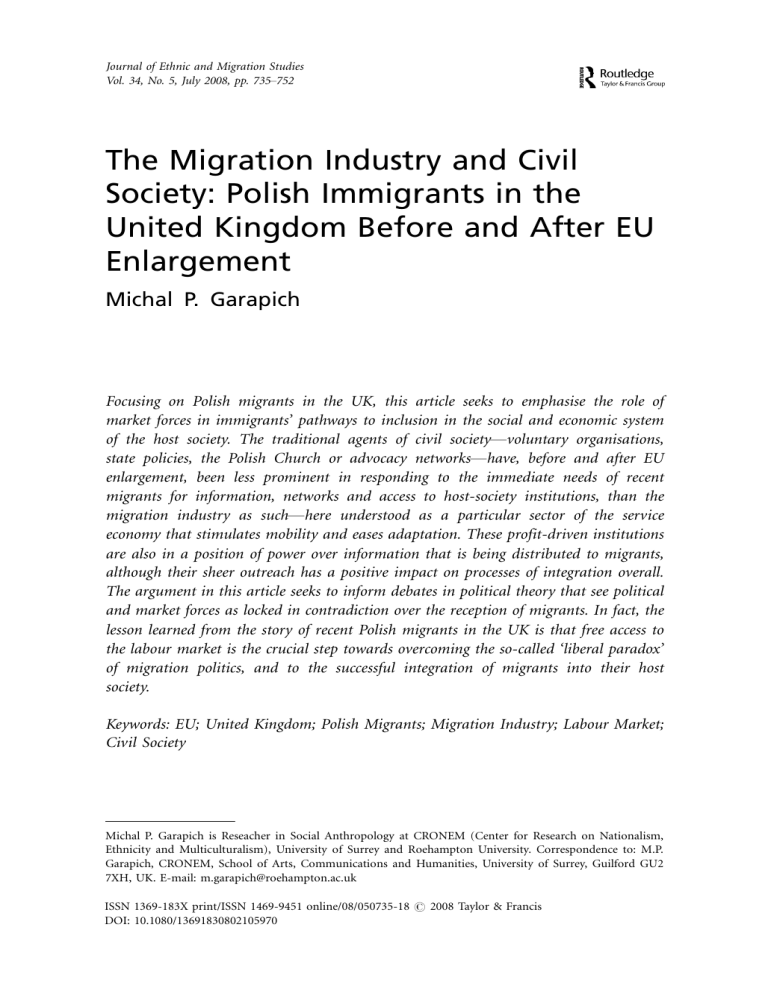
Journal of Ethnic and Migration Studies Vol. 34, No. 5, July 2008, pp. 735752 The Migration Industry and Civil Society: Polish Immigrants in the United Kingdom Before and After EU Enlargement Michal P. Garapich Focusing on Polish migrants in the UK, this article seeks to emphasise the role of market forces in immigrants’ pathways to inclusion in the social and economic system of the host society. The traditional agents of civil society*voluntary organisations, state policies, the Polish Church or advocacy networks*have, before and after EU enlargement, been less prominent in responding to the immediate needs of recent migrants for information, networks and access to host-society institutions, than the migration industry as such*here understood as a particular sector of the service economy that stimulates mobility and eases adaptation. These profit-driven institutions are also in a position of power over information that is being distributed to migrants, although their sheer outreach has a positive impact on processes of integration overall. The argument in this article seeks to inform debates in political theory that see political and market forces as locked in contradiction over the reception of migrants. In fact, the lesson learned from the story of recent Polish migrants in the UK is that free access to the labour market is the crucial step towards overcoming the so-called ‘liberal paradox’ of migration politics, and to the successful integration of migrants into their host society. Keywords: EU; United Kingdom; Polish Migrants; Migration Industry; Labour Market; Civil Society Michal P. Garapich is Reseacher in Social Anthropology at CRONEM (Center for Research on Nationalism, Ethnicity and Multiculturalism), University of Surrey and Roehampton University. Correspondence to: M.P. Garapich, CRONEM, School of Arts, Communications and Humanities, University of Surrey, Guilford GU2 7XH, UK. E-mail: [email protected] ISSN 1369-183X print/ISSN 1469-9451 online/08/050735-18 # 2008 Taylor & Francis DOI: 10.1080/13691830802105970 736 M.P. Garapich Introduction: The Migration Industry, Civil Society and the ‘Liberal Paradox’ Migration scholars often find themselves racing against a fast-moving reality. Not only is their subject of study mobile individuals, but the complexity of migration phenomena develops quicker than research can follow. The whole mosaic of a migration system can also be altered within a short period of time by a single geopolitical event. An excellent example of this has been recent EU enlargement and the influx of citizens of new member-states to the West. However, one needs to remember that Eastern European migration and particularly Polish migration were in full swing before 1 May 2004 (Düvell 2004; Górny and Ruspini 2004; Jazwinska and Okólski 2001; Morawska 2002; Okólski 2001; Romaniszyn 2000; Triandafyllidou 2006). Poles have constituted a highly mobile and visible migrant workforce for more than a century in Europe, and the 1990s were not exceptional in that respect (Iglicka 2001: 121; Mach 2005). In fact, it is often forgotten that the liberalisation of migration restrictions in the UK began before the enlargement in 2004. The British government’s decision to open the labour market was presented as an honourable and generous thing to do, but effectively it was simply a legal manoeuvre to legitimise already-established flows. The recent influx of Poles into the UK should be regarded as a continuation of a process that began more than a decade ago. Our preoccupation with the phenomenon shows a change in perception rather than a qualitatively different reality on the ground.1 But surely something qualitatively has changed since the enlargement? In this article I will put forward some fine-grained ethnographic data in order to understand the impact of the EU integration process on the day-to-day lives of migrants, exploring the dynamics of identity and community construction. I will argue that a crucial role in that process has been played by the migration industry, understood broadly as a set of specialised social actors and commercial institutions that profit directly not only from human mobility but also from effective adaptation into the new environment. That dual function determines the ease with which individuals decide to migrate and their relative ability to settle but at the same time to returnmigrate back to Poland. As a result, the migration industry becomes a powerful agent in setting and reproducing a self-sustaining ‘transnational social field’, understood in the words of Nina Glick Schiller as ‘unbounded terrain[s] of multiple interlocking egocentric networks’ (2004: 455). Robin Cohen (1997: 163) defines the phenomenon of the migration industry in the following passage: [. . .] despite the rigorous official control of immigration, there has been an extensive and rapid development of a ‘migration industry’ comprising private lawyers, travel agents, recruiters, organizers, fixers and brokers who sustain links with origin and destination countries. Although implicitly present in literature*the example of padroni in the history of Italian emigration or the vast literature on human trafficking being the most Journal of Ethnic and Migration Studies 737 prominent*the role of the migration industry has not yet been fully acknowledged. Rubén Hernández-León (2005: 11) notes: [. . .] previous attempts to systematically analyze one or multiple dimensions of the migration industry do not appear to have created a long term research agenda about the phenomenon or generated a lasting interest in theorizing its role in the social process of international migration. It is a topic woven into migration studies, but has not taken root either as part of a theory or as a concept integrating a broader theoretical framework. The commercial sustainability of migration flows for particular actors has also been highlighted by John Salt (2001) and in work on trafficking by Salt and Stein (1997: 468). Their focus on trafficking and the informal side of the industry, however, limits the role of it in other spheres of social life, most notably*as I will attempt to show* in the formation of new forms of social groups, expressing a new type of discursive practice and constructing a specific voice of migrants as they adapt to the host country. In an attempt to justify the conceptual usefulness of the notion of the ‘migration industry’, Hernández-León (2005) acknowledges the complex and fluid nature of the relationship between the migration industry and ethnic economies, the state and civil society. The ability to cross ethnic boundaries and at the same time to actively be part of the economic niche is one of the reasons for the success of these entrepreneurial activities. As the language of commercial interest and the experience of migration of different cultures and societies become more uniform and widespread, the ability of the migration industry to bridge cultural, social and state boundaries grows, the remittances-sending company Western Union being the most favourite example among scholars. There is thus a fine but sometimes blurred line between promoting its own business interest and those of one particular ethnic group. However, what it is important to realise is that many of these agents actively ease the incorporation and adaptation of migrants into the host society at the same time as helping them to maintain transnational links with the sending country. These agents are of particular interest here. Their multiple roles presuppose that the forces described above, although operating in what scholars would define as an ‘ethnic enclave’ (Light and Gold 2000), do not have to be ethnic or of immigrant origin at all, or that they can easily switch their interest and field of operations from one group to another. The often overlooked fact is that growing international migration has made migrants an important and highly profitable type of consumer. That consumption depends on a particular activity: mobility, both physical (in terms of space) and social (in terms of incorporation and integration in the host society). Enter immigration advisors, tax refund offices, business consultancies, money sending outlets, banks, travel agents, communication businesses, ethnic media, recruitment agencies, the ethnic food economy*all these booming economic activities directly target immigrant populations but do not have to be staffed or owned by immigrants or members of an ethnic community themselves, or they can 738 M.P. Garapich be staffed by members of an ethnic group in a very instrumental way (HernándezLeón 2005). The point of distinguishing the ‘migration industry’ from ‘ethnic niches’ lies first in the former’s explicit and direct role in stimulating further flows, thus becoming an additional pull factor since, through its growing sophistication, it lowers the risks of migrating. Secondly, by providing jobs it increases the chances of a successful economic and social adaptation into the host society. Thirdly, its inclusive nature is important*anyone can engage in the industry. The possibility of transcending ethnic boundaries makes it very effective in producing so-called ‘bridging social capital’ (Putnam 2000). Whilst ‘ethnic enclave’ presupposes a bounded, closed entity that works well within one institutionally complete system, ‘migration industry’ is the market face of transnational connections transcending ethnicity, class and cultures by linking particular localities to the global economy. I suggest, then, a working definition of ‘migration industry’ as a sector of service markets that uses human mobility, adaptation in the host country and the sustenance of a transnational social field as its main resource. The complex relationship between these transnationally oriented commercial activities, migrant populations and the host society puts the whole perspective on integration, civil society and markets on a different footing. One thing that the booming literature in transnationalism has established is that integration into the host society is not contradictory to sustaining transnational networks. This is precisely where the migration industry plays its crucial role. However, the academic discourse on social integration and civic participation of immigrants and on processes of construction of associational structures among immigrant groups focuses mostly on typical agents of civil society: the ‘non-profit’ voluntary NGO sector, state agency networks or particular diasporic organisations (see eg. Breton 1964; Brubaker 1998; Ireland 1994; Martiniello 1993; Sword 1996). Unfortunately, the communitarian or voluntary side of processes of construction of civil society, and the consequent political participation among immigrant groups, are biased towards a normative, neo-Toquevillian republican philosophy of communal engagement. It reifies the idea of an homogenous immigrant culture, with shared values and norms. It does not recognise a whole range of complexities and conflicting identities among diasporic civil societies, their heterogeneity and internal power relations and crossgenerational struggles. The monopolisation of representation by one segment or the elites of these groups and in-group power relations (Baumann 1996; Bousetta 2000; Eade 1989; Erdmans 1995; Garapich 2008), should be constantly taken into account. We need a better understanding of the economics and power relations underlying civic engagement and participation of groups, without the cliché of a reified culture. If we look closer, in fact, the picture dividing the associational life of ethnic groups from their market-oriented practices becomes blurred and untenable. In theoretical terms, therefore, the main reason for emphasising the notion of the migration industry is to problematise the strict conceptual boundary imposed by scholars of immigrant politics in tending to treat civil society as diametrically opposed to market forces. As a powerful stakeholder challenging the nation-state Journal of Ethnic and Migration Studies 739 (Harris 1996: 135) and developing a dynamic of its own (Castles and Miller 1998: 26, 978), the migration industry is set to destabilise this political view of immigration which still regards states and governments as the driving forces of international migration and the main actors in incorporating large populations of migrants. The methodological nationalism at work here (Glick Schiller and Wimmer 2003) leads scholarship to dominantly view liberal democracies as locked into a ‘liberal paradox’ where neat categories of ‘political opposition’ seeking closure and control over immigration are bound to clash with ‘market forces’ pushing borders open (Hollifield 2004). The paradox James Hollifield speaks of stems from inescapable contradictions built into the way that liberal democratic states deal with mass migration, which throws up different legal, political and economic rationales. Since the end of World War II, international economic forces (trade, investment, and migration) have been pushing states towards greater openness, while the international state system and powerful (domestic) political forces push states towards greater closure. This is a liberal paradox because it highlights some of the contradictions inherent in liberalism, which is the quintessentially modern political and economic philosophy and a defining feature of globalization (Hollifield 2004: 886). In other words, the paradox stems from the strong conceptual division between the political and the economic: ‘Hence the liberal paradox: the economic logic of liberalism is one of openness, but the political and legal logic is one of closure’ (Hollifield 2004: 887). However, a closer ethnographic investigation into how market forces, politics and the migration industry intersect and impact on transnational flows and host societies, shows a reality which is much more blurred. The economic interdependence creating new forms of transnationalism is far from being an obstacle to integration and further participation. In the particular case I am about to discuss, the term ‘immigration’ itself seems doubtful in this context. Different migrants operate within different legal and market opportunity structures; hence they use different resources to adapt themselves and integrate into the host society, and this results in different reactions from the hosts. Hollifield seems to be taking for granted the neat distinction between ‘internal’ and ‘external’ relationships that states and markets are engaged in as well as a neat distinction between migrants and natives*as if a substantial deterritorialisation of space, identities and politics had not taken place in the global and regional world of today. These neat distinctions are no longer much help, particularly in the context of the emergent EU space. With the expansion of the EU area of freedom of movement, the stratification of different kinds of migrants with an implicit hierarchy of belonging in that space becomes ever more clear. This means that Hollifield’s political ‘closure’ entails closure for some migrants, but only some* specifically migrants from particular countries and particular backgrounds. The paradox seems only tenable if we take these dichotomies for granted, but their cultural bias is clear. The closure did not happen in relation to Poles who, in the UK, 740 M.P. Garapich are often (positively) stereotyped in the media as a highly desirable kind of worker and more trustworthy because of their ‘cultural proximity’ (Fomina and Frelak 2008). That ‘proximity’ says it all*it assumes the greater the distance that migrants have travelled, the further away they are culturally. In order to address the limitations associated with the ‘liberal paradox’ identified with Hollifield, I take a more anthropological perspective. The migration industry concept explains and highlights the role that inclusion into a single EU labour market has had on recent developments among Polish migrants’ transnational networks and their processes of adaptation and social and economic incorporation. As I will illustrate, purely commercial and profit-oriented activities of Cohen’s so-called ‘fixers and brokers’ (1997: 163) have unintentionally resulted in an extraordinary development in the associational, civic, cultural and social life of Polish migrants in the United Kingdom. The data used in this article come from prolonged anthropological fieldwork among Polish migrant populations in the United Kingdom during the last four years. The article also draws extensively on an ESRC-funded study among Polish migrants in London conducted between autumn 2005 and summer 2006. Participant observation, in-depth interviews and diasporic press analysis were the main tools of gathering data. From ‘Illegals’ to EU Citizens As mentioned before, the migration industry not only oils the wheels of the migration system between post-communist countries and Western Europe, but it also eases migrants’ integration, empowering them as social and political participants in host societies. Neo-liberal economics*the philosophical foundations of the free movement principle*are therefore not only enlarging the pan-EU labour market, but also expanding the volume of participants in a pan-European civil society and creating a new class of socially and politically aware migrants. In their 2002 article, Adrian Favell and Randall Hansen showed that immigration policies in the EU are being primarily driven by markets, putting in doubt the commonly held idea of ‘fortress Europe’. If this is the case, market forces should also play a prominent role in accommodating migrants in their countries of settlement, thus creating additional niches and ethnic enclaves that cater for new arrivals along with the more established migrants. The model concentrating on the labour market and a classical economic rationale does not show the full picture. Once migrants obtain jobs they have other needs: to socialise, to maintain contact with distant relatives, to keep religious rituals alive and to reconstruct their identity against the backdrop of new ‘significant others’. This is all well-known in migration studies but what the Polish case in the last few years offers is a unique insight into how the creation of a migration industry, along with the evolution of immigration law, has stimulated emancipation, incorporation, and new identity formation. Journal of Ethnic and Migration Studies 741 Advisors and Business Establishment The Associate Members Agreement between the accession states and EU members, signed in 1993, stipulated that one of the provisions for entering the labour market was a right to establish businesses in EU states. It worked differently in each country, but in the UK, since the late 1990s, it gave Polish migrants a very effective means to enter the labour market (Düvell 2004). Since the process of establishing a business takes considerable time and requires a knowledge of bureaucracy, a group of immigration advisors emerged who quickly (in the years 200004) transformed the observable patterns of economic and labour behaviour of migrants in their ethnic economic niche. Most of these advisors began as low-key, back-door, one-person businesses, often with a single telephone number and private visits at home. They were rarely professional immigration lawyers but rather people who seized the opportunity to help others to fill out forms and follow procedures. Within a couple of years some of them emerged as very important social brokers, employers and leaders active in the local Polish public sphere. Previous research on Poles in London during these years predicted (correctly) that the self-employment schemes contributed to ‘deepening of the infrastructure of Polish social relations in London’ (Düvell 2004: 24). In fact, I would call this ‘deepening’ a boom in the Polish migrants’ industry. Between 2000 and 2004 around 40 immigration advice offices sprang up in and around London. That process was not entirely positive though. Castles and Miller rightly note that the migration industry may exploit migrants as well (1998: 26); some of the Polish advisors quickly developed into respectable business ventures, others turned out to be run by human smugglers and organised groups providing migrants with false documents (Garapich and Bany 2003). A practice of cheating clients was not uncommon and a significant number of advisors were investigated by Scotland Yard or the Office of Immigration Service Commission. Some were known to change venues and business names in order to attract new customers when things went wrong. In winter 2003, for example, the Home Office contacted the Polish Consular Office to return around 3,000 Polish passports that were submitted to the Home Office with an application for a selfemployment visa, but which could not be processed due to the advisor’s lack of licence or simply because the advisor had disappeared. This has not stopped many other migrants from using the same opportunity en masse. In the years 200104, tens of thousands of Polish migrants obtained the so-called ‘self-employed visa’ which allowed them to legalise their presence, work, pay taxes, take out mortgages, and be free to participate in the social and economic life of the UK. The popularity of the right of business establishment as an avenue of migration is even reflected by the Home Office (2003: 15) whose 2003 immigration statistics report notes that: 2003 saw an increase of 151 per cent in the number of persons granted an extension as a person of independent means or as businessmen to 24,800. . . . Significant increases occurred in nationals from Poland (up 156 per cent to 9,410). 742 M.P. Garapich The informality involved in the process is one of the key features of the birth of this particular sector of the migration industry. Now, liminal and borderland activity is of course nothing new in economies occupied by a foreign labour force (Kloosterman et al. 1999). Here, however, the difference is that advisors were in fact easing the passage from the grey economy into a formal one. From the fuzzy and highly ambiguous state of being officially tourists, illegal immigrants or visitors (Ruhs et al. 2006), migrants were channelled towards the legal status of being self-employed. Stretching the rules, negotiating the law and creating precedence were then part and parcel of that process. For instance, thousands of identical business plans were produced, the professions were often purely fictitious*mine as a ‘journalist’ was thus identical with that of many ‘carpenters’*and advisors explicitly shared with the clients the fiction behind the whole scheme, blinking their eyes every time the Home Office was mentioned. The system was ultimately attacked by the right-wing press and the Conservative Party, and various scams uncovered in March 2004 led to the downfall of the Minister for Immigration, Beverly Hughes. The scams described in the press concerned the processes of getting the same visa in Bulgaria. Here the only thing that differed from the Polish situation was that for Poles visas were issued for someone already in the UK, not a potential immigrant, so it was more an effective method for switching migrant status* from tourist or student visa to business visa. Some Polish advisors were boasting of doing things that were technically impossible under British law. One of them blatantly advertised his services in the local Polish press as the ‘legalisation of illegals’*surely a rude shock for any Home Office official who might have read it. Despite these pathologies and the high degree of informality and bending of rules, the system worked rather well. It is a reminder, too, that the actual liberalisation of the immigration regime for Polish migrants took place well before EU enlargement. What concerns us here is the fact that it gave a huge boost to a group of immigrant entrepreneurs. Charging £500 a visa, plus extras like arranging National Insurance, setting up a bank account and Inland Revenue registration, the ‘business-visa’ market generated millions of pounds for a relatively small group of people. The New Polish Migrant Media In the immediate run-up to enlargement, successful advisors already began to realise that in order to keep afloat they would need to adapt to the new circumstances by which Poles would be free to come and work in the UK without restrictions. Hernández-León (2005) lists all sorts of businesses classified as being typical to the migration industry in relation to Mexican migration to the US, but the Polish case shows something quite specific. By 2004 a vibrant, highly competitive and expanding media culture was flourishing on the foundations laid by the immigration advisors’ offices, from which four weekly and one fortnightly magazines are currently published, each with a circulation of between 20,000 and 60,000. By 2007, one could count at least a dozen different websites and five internet radio stations attracting visitors from both sides of the migration chain between Poland and the Journal of Ethnic and Migration Studies 743 UK. Adapting to the new environment and to the needs of clients, many advisorsturned-business-consultants created a richly informative media sphere which they keep either as part of their business or as their main advertising outlets. Other advisors turned to recruitment or tax advising companies. However, all linked their activities strongly to the media sphere, which quickly emerged as a public forum where things could be discussed, news digested and an imagined community formed. In his classic study of the ‘institutional completeness’ of ethnic communities, Raymond Breton stresses that ethnic publications are a powerful tool in creating and developing interpersonal ties (Breton 1964). Newspapers give information which before was only obtained through informal networks, fuelling situations of dominance and exploitation. They also formalise and lift the insecurity embedded in reliance on networks based on informal relations and trust. Media and especially internet use among migrant groups fulfil an important set of functions, and a growing body of literature addresses their crucial role in establishing mutual connectedness and community construction (Georgiou 2002; Hiller and Franz 2004; Karim 2003; Panagakos 2003). Media helps to create not only a business and marketing niche but*in line with Benedict Anderson’s argument about the role of the press in forging an imagined community (Anderson 1991), and Robert Putnam’s about readership as one of the marks of a vibrant civil society and mutual connectedness (Putnam 2000)*they are actively involved in new identity negotiations, social construction of a group and creating new bonding mechanisms within a dispersed immigrant population. However, what is even more important in the case discussed here is that they bind a group together and give voice to those previously silent and excluded. The diasporic public sphere has been previously rather dominated by the established Polish community originating from the time after the World War II (Sword 1996). These days, Polish migrants can learn from new titles not only how to get a National Insurance card, find jobs and minimise the risks associated with migration, but also how to claim benefits, use trade union membership, sue a dishonest employer, or lobby local politicians. They can also learn about the attitude of British society towards them, what differences there are between different cohorts of Polish migrants, how different people identify themselves and generally how to organise themselves. The public sphere provided by the media has made migrants more selfreflexively aware of differences, similarities and the peculiarities of British life.2 Within a short time, it can be observed that informality, small networks, and a strong suspicion towards co-ethnics and authorities*features which strongly characterised the world of Polish migrants in London in the scant past research done among them (Düvell 2004; Jordan 2002)*are slowly being redefined, evolving into a much more public, formalised and participatory structure of immigrants’ social space. Due to new market initiatives and opportunities, previously informal networks are being formalised, publicised and are coming out of the shadows of the informal economy or underground life.3 But this construction of a new set of institutionalised networks, commercial advocacies and mutual connectedness did not 744 M.P. Garapich emerge out of some abstract sense of common heritage, duty towards extended kinship group, cultural affiliation or essentialist definitions of national identity or shared common set of values. Rather, it was the migrants’ inclusion in the labour market which created a niche for agents to ease incorporation and spread information assisting in fuller integration. To put it briefly, in the case of Polish migrants, no voluntary NGO could have facilitated migrants’ entry into their host society better than the media and the underlying migration industry have done. In fact, traditional Polish ethnic associations and institutions, especially the Polish Catholic Church, have been rather slow in reacting to and assisting the newcomers. Such institutions have been more interested in maintaining dominant positions and their symbolic power (Bourdieu 1989) than offering advocacy, support networks or a common platform of inter-generational communication (Garapich 2008). Since, by definition, the market-driven role of new media is to enlarge the circle of participants, the new media sphere created on the ground by the migration industry is hugely active in the creation of ‘bridging social capital’ (Putnam 2000), that reaches outside of the closed circle of co-ethnics. This inclusive aspect of the migration industry distinguishes it from the typical effects of a migrant niche. The best example is probably the massive display of common religious identity after the death of John Paul II, when around 30,000 people marched in front of the Palace of Westminster. This march had been organised, within a few days, mainly using highly popular internet chat-rooms and websites. It attracted not only Poles but Catholics in general. Other important events organised by the papers are the one-day job fairs, events where around 5,0008,000 people seeking work turn up and meet recruitment company representatives, trade union officials, local government members, language teachers and CV-writing trainers. The fairs also often transcend ethnic ties and many migrants from other mainly Eastern European states also attend. The owner of one of the magazines, who also runs a business consultancy, recruitment company and property maintenance company and has a turnover of £3m a year, is actively marketing his business among other migrant groups: Ukrainians, Bulgarians, Slovaks and others. The most prominent example, however, comes from the established British media outlet that quickly recognised the potential of this particular niche. In February 2006, the publishers of the weekly TNT magazine, catering previously mainly for Commonwealth migrants, launched an English-language Fusion magazine: a weekly targeted at Eastern and Central European migrants. In June 2006, they began to run a section in Polish. Since TNT is owned by the Guardian Group, it came then as no surprise that on 21 July 2006 the entire G2 section of The Guardian was devoted to ‘One Million Poles in Britain’, with articles from the Polish editorial staff of Fusion, features on Polish migration to the UK, and introductions to Polish delis and club culture in London. As can be seen, it is precisely with its ability to bridge ethnicities, social classes and consumer needs that the migration industry renders conceptual divisions between ‘ethnic niche’ and ‘dominant economy’ or between host society and newcomers irrelevant, artificial and normatively biased. From the point of view Journal of Ethnic and Migration Studies 745 of debates on integration, incorporation and multiculturalism, such a public exposure in a positive light from a leading newspaper far exceeds any government or NGO campaign. The twist in this is that Fusion went bust after just a few months of operating. The ambition to address all new member-states’ citizens in English proved too far-fetched. Crossing ethnic boundaries seems tempting, too, for the other side. In April 2008 one of the Polish media outlets launched an English-language monthly addressed to British and European audiences and aimed at promoting Eastern/Central European SMEs. Of course both settings*informal networks of migrants and formal, institutionalised forms*find themselves in direct competition. After all, they fight for the attention of the same people and the power to transmit information that is most useful to migrants. It puts them in a position of control and this control can sometimes be abused. Magazines owned by immigration advisors may withhold crucial information in order to make the client use their services. Some journalists working at these outlets express their frustration that often the role of information distribution comes into conflict with the financial interests of advisors, who for instance charge for helping migrants fill out forms for child benefits. In an atmosphere of competition, this is condemned by other outlets and sometimes challenged by the journalists themselves. Nevertheless it is the sheer ability to widen the circle of participants that accounts for the success of the migration industry: according to some figures, it concerns a weekly readership of around a quarter of a million Poles in the UK. With the stimuli of the new media, people with common interests meet, collective action is planned and a perception of mutual fate is constructed. They constitute strong grounds for the emergence of a civil society where social capital is being produced, trust generated and interconnectedness expanded. This is also a connectedness of transnational character, since magazines have managed to establish themselves as voices of the Polish migrants back in Poland. This became clear when one magazine organised an emergency information point just after the 7/7 London bombings in which, among the many victims, three Polish nationals died. Thousands of telephones and faxes from anxious relatives in Poland thus elevated a relatively small magazine to the front pages of the Polish media back home. Remittances and Businesses in the Emergence of a New Public Sphere Companies specialising in sending remittances form a different but highly significant section of the migration industry. Western Union, along with MoneyGram, has been crucial in terms of sponsorship in various community and social events: from religious festivals and arts events to political protests. Among many events these firms were sponsors of meetings with the leader of the Polish opposition in Poland in London, Polish rock and hip hop concerts and even a Christian pilgrimage to Laxton Hall.4 Many of the staff of these businesses are also highly active members of new 746 M.P. Garapich media or associations, so it is difficult to disentangle the relationship between the professional activism and civic activism of particular individuals. All this alters our perceptions of civil society: this is doing business and ‘community’ work at the same time. It is a far cry from ‘the world of voluntary associations’ as Robert Putnam (2000) sees it; however, the important thing is that they serve a similar purpose. The role of immigration advisors, job brokers, newspapers, new media, shops, travel agents, money-sending offices and bars where migrants meet, may be recognised by some scholars, but they are not always regarded as institutional settings for creating a grassroots, civic culture. In fact, it is often forgotten that it is sometimes impossible for an immigrant to participate without the necessary resources, so people occupying specific social niches have a vantage point from which to become active leaders. Hence there are people who manage to combine their daytime work with assistance and active civic participation. Remembering the role of the famous militants-cafetiers*Algerian bar-owners who were able to mobilise migrants in France during the 1950s and 1960s (Stora 2004)*we must always, in the context of immigration, look at alternative forms of participation, even if they look like pure business ventures. Scholars of the politics of immigration typically hold the view that integration and incorporation are the responsibility of the state or host civil society (see Brubaker 1998; Ireland 1994), understood in terms of citizenship or as networks of voluntary associations*both from the ethnic group as well as the host society. But as migratory movements within the EU are governed by the expanding free market, of which free movement is a direct outcome, the processes of immigrant integration and engaging immigrants in participation on the ground are also strongly determined by market forces and hence by the economic avenues of opportunities for immigrants to create their own migration industry. Extending the role of various civic and commercial advocacy networks as crucial actors in integrating newcomers to the political and social setting of the host country may therefore be seen as the other side of the coin of market-driven liberalisation of immigrant politics in EU member states (Favell and Hansen 2002). In sum, market structures and opportunities in engaging with the migration industry stimulate the emergence of political and civic entrepreneurs. In the process of new migrant identity formation, the ethnic media play a crucial role in the dispersal of information about employment, legal issues, and political and social rights*for instance by highlighting issues like the industrial disputes between Polish migrants and Tescos or Woolworths.5 These themes were virtually absent from public debates within Polish diasporic institutions prior to EU enlargement, despite*as shown above*a large presence of Polish migrants prior to this event. The most important and politically exposed civic action undertaken by Polish migrants using the vehicles of the migration industry was staged during the first half of 2006. It centred on the issue of a 30-year-old bilateral agreement against double taxation between Poland and the UK, an agreement that effectively resulted in Polish migrants having to pay an extra tax in Poland on top of what they paid to the UK Journal of Ethnic and Migration Studies 747 Inland Revenue. It was a particularly harsh law for people investing in Poland or sending remittances. The problem came to public attention thanks to the new media. Within a couple of months of internet and newspaper activity there was a mass uproar and protests. Stimulated by magazines trying to outdo one another, Polish migrants signed at least 50,000 petitions to the Polish premier, minister of finance, the leader of the Sejm and the ombudsman. Leading Polish politicians began to frequent meetings organised and sponsored in London by the media outlets and money-sending businesses. Dozens of articles appeared in the Polish press in Poland, with one newspaper strongly lobbying the government through a press campaign. The climax came in March 2006 when ‘Poland Street’*a newly formed association representing Polish migrants, with one leader working in one of the magazines and another in a business sending remittances*in partnership with one of the magazines, organised an unprecedented street rally in front of the Polish consulate in London. Around 1,000 migrants voiced their frustration and anger. The protest gained huge political and media coverage in Poland and explicit appeals from the organisation to undertake civil disobedience by refusing to pay the taxes or publicly renouncing Polish citizenship gained sympathy. It comes as no surprise that the leaflets calling for the street rally were sponsored by Western Union, with its logo on them: the whole event would not have happened without the active interest of the migration industry. After all, the tax law was penalising the most prized participant in the transnational social field*the circular, transient, transnationally oriented Polish migrant in his/her late 20s or early 30s who frequently flies home (using travel agents and cheap airlines), sends remittances (using money-sending offices) and stocks up with Polish food at Asda (which imports food via Polish wholesalers based in the UK). Grounding the ‘Liberal Paradox’ In their interviews with Polish migrants in London, Jordan and Düvell noted a considerable tone of mistrust towards fellow-ethnics. Reporting each other to the immigration officials, greed, ruthless competition, the practice of ‘selling’ employment, a collapse of sense of community, mistrust: these were common elements observed. Was this the price Poles were paying for market liberalisation and open borders, the authors asked? (Düvell 2004: 25; Jordan 2002: 4). But the argument could be turned the other way. It was essentially the lack of freedom of mobility and participation caused by immigration restrictions before enlargement that contributed to Poles’ sense of insecurity and led to these ‘Darwinian’ life strategies. Illegality in this period impeded not only their job prospects but also their ability to forge ties, institutionalise their presence, join trade unions, and establish strong economic bases. These are all things they are doing now in a much less restricted context. The freedom that came with the open labour market translated itself into freedom to meet, socialise freely, do business and form communities with an agenda: be it a close-knit circle of Polish couriers, the Polish gay community getting together, or Polish mothers meeting their co-ethnics with kids. Freedom from deportation also partly 748 M.P. Garapich removed the in-built inequalities where fellow-ethnics exploit one another. Nowadays, an average Polish migrant can simply opt out and look for employment elsewhere, outside the community. The liberalisation of immigration law and the opening of the European labour market created, as Favell and Hansen state (2002), ‘avenues of immigrant inclusion’ that have not existed before. This raises important questions relating to the political role that migrants from former communist countries are set to play in their countries of settlement and their impact on the democratic process. As the biggest users so far of EU citizenship provisions in relation to freedom of movement, they are not only reshaping the demographic and labour map of the EU but also giving a new empirical meaning to what constitutes having European citizenship. This symbolic provision, as granted in the Treaty of Maastricht, is taken for granted by citizens of the pre-enlargement EU, and is often undervalued by scholars as an empty concept (eg. Haynes 1999). As I have attempted to illustrate, however, for Polish migrants it represented a great act of empowerment: granting previously denied rights and opportunities that quickly translated into social participation, self-awareness and political incorporation. Recent interest in the Polish migrants’ vote shown by Scottish political parties in last year’s regional elections and by London mayoral candidates this year, or an extensive recruitment campaign by British trade unions, are cases in point*EU citizenship has a much more politically resourceful meaning than has previously been assumed.6 More broadly, the role of the migration industry in developing a strong transnational social field and incorporating migrants is still a largely unexplored effect of liberal democracies’ policies on immigration. Market-oriented activities of Polish migrants, embodied in the proliferation and complexity of the migration industry, have resulted in the removal of vast numbers of Polish migrants from insecurity, taking them from a state of marginality into a visible public and political sphere. The migration industry is slowly helping them to negotiate their presence in the social and political stage of the host society, parts of which increasingly have their own stake in the industry, as shown by the case of The Guardian, or a recent campaign by British banks to market special bank accounts for Polish migrants. If this is the case we may be closer to overcoming James Hollifield’s ‘liberal paradox’. The contradiction here rests on an assumption of a fixed and non-negotiable boundary between the state, the market and civil society. As I have attempted to show, these are not as clear-cut; on the ground, they merge and are mutually dependent. Hollifield is right, of course, when speaking about the deep cultural unease about migration running across the Western world. However, this unease differentiates between different kinds of migrants and is therefore not universal. Different liberal democracies close their doors to different migrants; hence the paradox is not about immigration per se but particular cultural traits that are constructed, reified and stigmatised as difficult to integrate, or un-Western (Stolcke 1995). The inclusion of citizens of new member-states leads to the exclusion of others. The most recent reform of immigration law in the UK effectively makes it harder for migrants from outside the EU to enter Britain. On a more discursive level, praise from the British Journal of Ethnic and Migration Studies 749 public for Polish characteristics such as ‘hard-working’ and having a strong ‘catholic work ethic’ (sic!) seems highly informative. Stressing their ‘cultural proximity’ assumes a hierarchy of belonging, with some being more distant than others. Hollifield’s state-centric model does not address these distinctions across migrant groups, linked to differential positions of migrants within the regional integration process. Looking at the scene on the ground, we see that market forces are also able to shape the stage of local politics and civil society through the educational role of the migration industry, especially the new media which have shown the capacity to institutionalise and formalise transnational social fields. The paradox seems less obvious when we look beyond state-centred perspectives and see that the transnational character of the migration industry puts economic liberalism and political openness into a deeper and more functional relationship than previously envisaged. The case of Polish migrants and the role of the migration industry in their incorporation into British society prove that the integration of immigrants and their emergence as social actors are mutually reinforced by market forces which stimulate growing mobility and establish a functional and dynamic transnational field. The expanding migration industry catering to migrants contributes to greater openness of the policies formed by host states. If more migrants are drawn into the British financial and welfare system by this, it is not due to specific social policy of the state, traditional ethnic associations or the Church, but reflects the dynamics of the migration industry itself. Adopting the migration industry perspective enables us to look beyond the neat divide of politics and economics, and acknowledge that economic empowerment remains the first step to successful integration and political inclusion in the host state. However*and here Hollifield is absolutely right*there is always someone who is being excluded by the politics of migration. The knee-jerk reaction of the British government in excluding the extension of similar labour rights to Romanians and Bulgarians in the UK proves that the paradox is enduring. But it does not have to be inevitable; there is an alternative model. The lesson learned from the story of Polish migrants is that free access to the labour market is the crucial first step towards overcoming the liberal paradox that besets liberal democratic states. Acknowledgements I wish to express deep gratitude to people who shared valuable comments on earlier versions of this article and helped it achieve its current form, particularly Adrian Favell, Tim Elrick, Norbert Cyrus and Vron Ware. Notes [1] For instance 30 per cent of migrants registered in the Workers Registration Scheme in the UK were in the country before that date. According to Home Office statistics, in 2003, the year before the enlargement, when migrants’ information networks were already busy in 750 M.P. Garapich [2] [3] [4] [5] [6] preparation for the final lifting of restrictions, 360,000 Poles crossed into the UK (in 2002 that figure stood at 298,000). For example, one of the magazines is organising a literature and poetry competition on narratives about migration experience. The emergence of a vibrant Polish hip hop transnational culture in the UK or a politically active Polish gay community are two examples here. This yearly event is a mixture of religious, sport and youth activities. Laxton Hall is a retirement home owned by the Polish Catholic Mission in England and Wales. With the influx of newcomers, the yearly pilgrimage has become an established and renowned event. See Bhttp://www.anarkismo.net/newswire.php?story_id 1084 and Bhttp://www.man chesteronline.co.uk/men/news/s/177/177354_woolies_accused_over_polish_workers.html See Bhttp://www.sundaymail.co.uk/news/tm_objectid 17350622&method full&siteid 64736&headline glosuj-na-mnie*name_page.html References Anderson, B. (1991) Imagined Communities: Reflections on the Origin and Spread of Nationalism. London: Verso. Baumann, G. (1996) Contesting Culture. Cambridge: Cambridge University Press. Bourdieu, P. (1989) ‘Social space and symbolic power’, Social Theory, 7(1): 1425. Bousetta, H. (2000) ‘Institutional theories of immigrant ethnic mobilisation: relevance and limitations’, Journal of Ethnic and Migration Studies, 26(1): 22945. Breton, R. (1964) ‘Institutional completeness of ethnic communities and the personal relations of immigrants’, American Journal of Sociology, 70(2): 193205. Brubaker, R. (1998) ‘Immigration, citizenship, and the nation-state in France and Germany’, in Shafir, G. (ed.) The Citizenship Debates: A Reader. Minneapolis: University of Minnesota Press, 13164. Castles, S. and Miller, M.J. (1998) The Age of Migration. London: Macmillan. Cohen, R. (1997) Global Diasporas: An Introduction. London: UCL Press. Düvell, F. (2004) Highly Skilled, Self-Employed and Illegal Immigrants from Poland in United Kingdom. Warsaw: Centre for Migration Studies, Working Paper 4. Eade, J. (1989) The Politics of Community: The Bangladeshi Community in East London. Aldershot: Avebury. Erdmans, M.P. (1995) ‘Immigrants and ethnics: conflict and identity in Polish Chicago’, The Sociological Quarterly, 36(1): 17595. Favell, A. and Hansen, R. (2002) ‘Markets against politics: migration, EU enlargement and the idea of Europe’, Journal of Ethnic and Migration Studies, 28(4): 581601. Fomina, J. and Frelak, J. (2008) Next Stopski London. Public Perceptions of Labour Migration within the EU. Warsaw: Institute of Public Affairs, online at http://www.isp.org.pl/files/ 17552220390447906001202899581.pdf Garapich, M. (2008) ‘Odyssean refugees, migrants and power: construction of the ‘‘other’’ within the Polish community in the United Kingdom’, in Reed-Danahay, D. and Brettell, C. (eds) Immigrants and the Practice of Citizenship. Chapel Hill, NC: Rutgers University Press, 21037. Garapich, M. and Bany, K. (2003) ‘Kariera londynskiego Dyzmy’, Dziennik Polski i Dziennik Zolnierza, 56. Georgiou, M. (2002) ‘Diasporic communities online: a bottom up experience of transnationalism’, Hommes et Migrations, 1240: 1018. Glick Schiller, N. (2004) ‘Transnationality’, in Nugent, D. and Vincent, J. (eds) A Companion to the Anthropology of Politics. Malden, MA: Blackwell, 44867. Journal of Ethnic and Migration Studies 751 Glick Schiller, N. and Wimmer, A. (2003) ‘Methodological nationalism, the social sciences and the study of migration: an essay in historical epistemology’, International Migration Review, 37(3): 576610. Górny, A. and Ruspini, P. (2004) Migration in the New Europe: EastWest Revisited. Basingstoke: Palgrave Macmillan. Harris, N. (1996) The New Untouchables: Immigration and the New World Worker. Harmondsworth: Penguin. Haynes, M. (1999) ‘Setting the limits to Europe as an imagined community’, in Dale, G. and Cole, M. (eds) The European Union and Migrant Labour. Oxford: Berg, 1743. Hernández-León, R. (2005) The Migration Industry in the MexicoU.S. Migratory System. Los Angeles: University of California, California Center for Population Research, On-Line Working Paper Series 049-05, online at Bhttp://www.ccpr.ucla.edu/ccprwpseries/ ccpr_049_05.pdf , accessed 27 July 2007. Hiller, H. and Franz, T. (2004) ‘New ties, old ties and lost ties: the use of new media in diaspora’, New Media and Society, 6(6): 73152. Hollifield, J.F. (2004) ‘The emerging migration state’, International Migration Review, 38(3): 885 912. Home Office (2003) Control of Immigration: Statistics 2003. London: Parliamentary Stationery Office, Home Office Command Paper, online at http://www.archive2.official-documents.co.uk/document/cm63/6363/6363.htm, accessed 31 July 2007. Iglicka, K. (2001) Poland’s Post-War Dynamic of Migration. Aldershot: Ashgate. Ireland, P. (1994) The Policy Challenge of Ethnic Diversity. Cambridge, Mass: Harvard University Press. Jazwinska, E. and Okólski, M. (eds) (2001) Ludzie na hustawce. Migracje miedzy peryferiami Polski a Zachodu. Warsaw: Scholar. Jordan, B. (2002) Migrant Polish workers in London. Mobility, Labour Markets and Prospects for Democratic Development. Paper presented at the conference ‘Beyond Transition, Development Perspectives and Dilemmas’, Warsaw, 1213 April. Karim, K. (2003) The Media of Diaspora. London: Routledge. Kloosterman, R., van der Leun, J. and Rath, J. (1999) ‘Mixed embeddedness: (in)formal economic activities and immigrant businesses in the Netherlands’, International Journal of Urban and Regional Research, 23(3): 25367. Light, I. and Gold, S.J. (2000) Ethnic Economies. San Diego: Academic Press. Mach, Z. (2005) ‘Polish diaspora’, in Gibney, M. and Hansen, R. (eds) Immigration and Asylum: From 1900 to the Present, Volume 2. Santa Barbara: Clio, 47781. Martiniello, M. (1993) ‘Ethnic leadership, ethnic communities’ political powerlessness and the state in Belgium’, Ethnic and Racial Studies, 16(2): 23655. Morawska, E. (2002) ‘Transnational migration in the enlarged European Union: a perspective from the East and Central Europe’, in Zielonka, J. (ed.) Europe Unbound. Oxford University Press, 16191. Okólski, M. (2001) ‘The transformation of spatial mobility and new forms of international population movements: incomplete migration in Central and Eastern Europe’, in Dacyl, W.J. (ed.) Challenges of Cultural Diversity in Europe. Stockholm: CEIFO, 57109. Panagakos, A. (2003) ‘Downloading new identities: ethnicity, technology and media in the global Greek village’, Identities, 10(2): 199217. Putnam, R.D. (2000) Bowling Alone: The Collapse and Revival of American Community. New York: Simon and Schuster. Romaniszyn, K. (2000) ‘Clandestine labour migration from Poland to Greece, Spain and Italy: anthropological perspectives’, in King, R., Lazaradis, G. and Tsardanidis, C. (eds) Eldorado or Fortress? Migration in Southern Europe. London: Macmillan, 12544. 752 M.P. Garapich Ruhs, M., Anderson, B., Rogaly, B. and Spencer, S. (2006) Changing Status, Changing Lives. Oxford: COMPAS working paper. online at http://www.compas.ox.ac.uk/changingstatus, accessed 28 July 2007. Salt, J. (2001) ‘The business of international migration’, in Siddique, M.A.B. (ed.) International Migration into the 21st Century. Essays in Honour of Reginald Appleyard. Cheltenham: Edward Elgar, 86108. Salt, J. and Stein, J. (1997) ‘Migration as a business: the case of trafficking’, International Migration, 35(4): 46794. Stolcke, V. (1995) ‘Talking culture: new boundaries, new rhetorics of exclusion in Europe’, Current Anthropology, 36(1): 124. Stora, B. (2004) Algeria. A Short History. Ithaca: Cornell University Press. Sword, K. (1996) Identity in Flux. London: School of Eastern and Slavonic Studies. Triandafyllidou, A. (ed.) (2006) Contemporary Polish Migration in Europe. The Insiders’ Story. Ceredigion and Washington DC: The Edwin Mellen Press.
